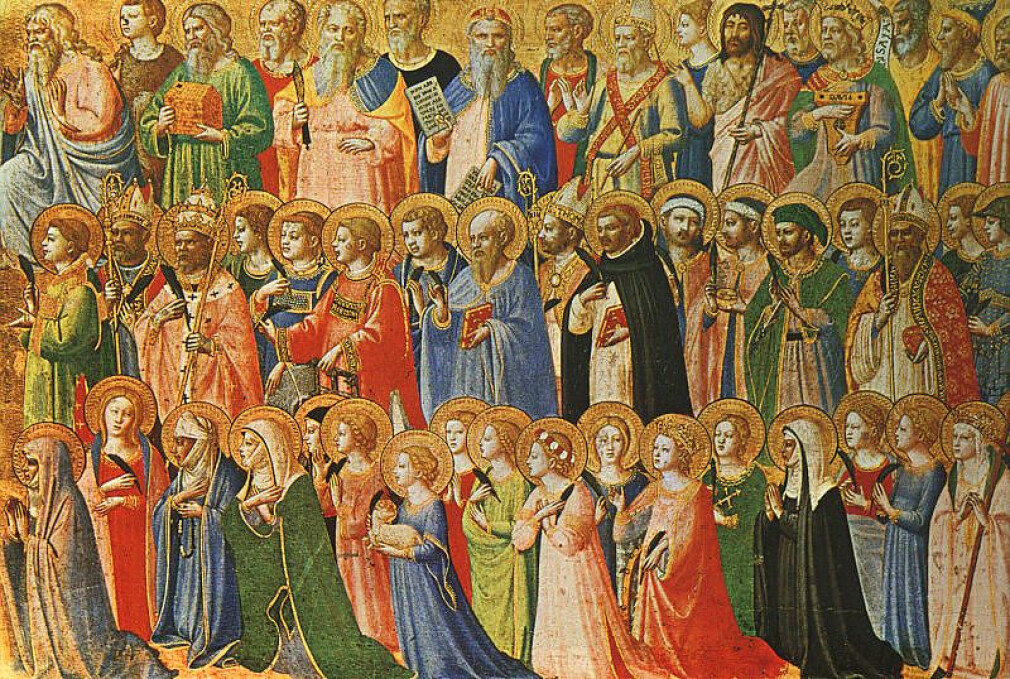An Instructed Sanctus

Last Sunday, the Rev. Luke Jernagan, the Rector of St. Peter’s, led us in the second part of our Instructed Eucharist. On both June 17 and September 2, the Sermon was taken up with an explanation of our service of Holy Eucharist, the service that begins (in its contemporary language “Rite II” version) on page 355 of the Book of Common Prayer.
And, as I did in June, I would like to offer a musical complement to that instruction.
When I started as a freshman at the Oberlin Conservatory of Music, I thought I was already pretty well-read and knowledgeable about music. So, before classes began, I showed up at an exam to try to place out of the freshmen-level Introduction to Music History course. Halfway through the exam, I realized I didn’t know as much as I thought I did, but by then I wasn’t too bothered by that fact. The professor, Sylvan Suskin, had an incredibly engaging manner, and he was playing pieces of music for us that I desperately wanted to know more about.
Once the Intro to Music History course began, I eagerly went to the music library to complete our first listening assignment. It was a marvelous compilation (on cassette tape!) of the Sanctus throughout music history.
The Sanctus is one of the parts of the Ordinary of the Mass, all of which we find in our Book of Common Prayer and Hymnal today:
- Kyrie (“Lord, have mercy upon us”)
- Gloria in excelsis (“Glory be to God on high”)
- Credo (“We believe in one God”)
- Sanctus (“Holy, holy, holy Lord”)
- Agnus Dei (“Lamb of God”)
The cassette in the Oberlin Conservatory Music Library began with plainsong and continued with different settings of the Sanctus by various composers through every era of music history. I wish I could remember the specifics of what was on that tape, but I do clearly remember one that stuck with me because it was unlike anything I’ve ever heard. It was the Sanctus from Leonard Bernstein’s ambitious Mass, a musical theater piece commissioned by Jacqueline Kennedy for the opening of the Kennedy Center in Washington. (We've just passed the 100th anniversary of Bernstein's birth, which was on August 25.)
This past Sunday, the Reverend the Rector did an admirable job of explicating all that takes place in the portion of the service we refer to as Holy Communion. And here, as in the first part of the service (“The Word of God”), music has an important role to play.
One piece of the service that has captured the attention of church musicians and those who think theologically about worship is the Sanctus.
Interestingly, our service bulletins refer to this piece of music as "Sanctus", but the Prayer Book does not use this Latin name. The words in question are these:
Holy, Holy, Holy Lord, God of power and might,
heaven and earth are full of your glory.
Hosanna in the highest.
Blessed is he who comes in the name of the Lord.
Hosanna in the highest.
The Prayer Book indicates that words are to be sung (or said, if you attend the 8:00 a.m. service) by the Celebrant and People together. (It seems significant that is one of four portions of the liturgy that have this instruction. The other two are the Memorial Acclamation and the Postcommunion Prayer. The Lord's Prayer is, confusingly, preceded by the rubric "People and Celebrant". Go figure.)
And here is where your Music Director finds some divided loyalties. That old cassette tape in the music library helped me hear the broad sweep of music history from the earliest days of the church to Leonard Bernstein’s pushing-the-envelope. Not all of the music on that tape was written for liturgical use (certainly the Bernstein wasn’t!) but much of it was.
So, while most of the time we end up following the rubric in the Book of Common Prayer for the “Celebrant and People” to sing the Sanctus together, we also sometimes take part in that great historic tradition available to us of different choral settings of the Sanctus (and/or the Kyrie, Gloria in excelsis, and Angus Dei – all parts of the “Ordinary” of the Holy Eucharist). The well-worn settings of service music by Healey Willan, William Mathias, and Robert Powell that we know at St. Peter’s allow us all to sing these words. But at other times, we pick up a setting of music for Holy Communion by a composer such as Palestrina or Howells written specifically for choral forces.
But whether we sing all together, or we pray the words as the choir sings a choral setting, we “[join] our voices with Angels and Archangels and with all the company of heaven, who for ever sing this hymn to proclaim the glory of your Name”.
This is a moment in our liturgy when we intentionally open our liturgy to the spiritual realities that we cannot see – that great cloud of witnesses who surround our parish church and sing with us.
In the Sanctus, we join in the song that is going on all the time around God’s throne but is only just outside our human hearing.
And because this celestial song of praise is so profound and beyond our knowing, I think it is a wonderful gift that at St. Peter’s, and other churches who partake in this choral tradition, we can experience many different ways of singing the Sanctus, as it has been imagined throughout history. Since we worship together with those who have gone before us, it is meet and right that our music – especially at this particular holy moment in our liturgy – reflect that rich chronological diversity.
Plainsong
G. P. da Palestrina
J. S. Bach
W. A. Mozart
Ralph Vaughan Williams
Herbert Howells
Lennox Berkeley
Charles Wuorinen
Jonathan Dove
Nico Muhly

